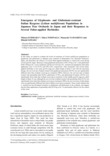In this study, we aimed to evaluate the levels of resistance of Lolium multiflorum populations to glyphosate and glufosinate in Japanese pear orchards in Hamamatsu city, Shizuoka Prefecture, Japan, and determine the efficacy of several foliar-applied herbicides to control this weed during several growth stages. Bioassays using glyphosate-potassium (1.08–2.70 kg ai ha-1 and glufosinate (0.60–1.00 kg ai ha-1) were conducted, and the survival rates of L. multiflorum populations after foliar application were 11.1%–53.3% and 0.0–5.6%, respectively. After treatments with several foliar-applied herbicides in the early growth stage (at a plant length of about 5 cm) with the maximum dosage, the survival rate of plants treated with glyphosate-potassium (38.9%) was not significantly different from that of plants receiving no treatment (100%). However, the survival rates of plants treated with quizalofop-ethyl (0.0%), glufosinate (17.8%), and glufosinate-P-sodium (18.9%) were significantly lower than that of plants receiving no treatment. In the middle growth stage (at a plant length of about 35 cm), although the survival rate of plants treated with quizalofop-ethyl (8.3%) was significantly lower than that of plants receiving no treatment (100%), the survival rates of other plants were not significantly different from that of plants receiving no treatment. These results indicate that L. multiflorum has developed resistance to glyphosate and glufosinate in the orchards, and suggest that the foliar application of quizalofop-ethyl (0.74 kg ai ha-1) is particularly effective for the control of this weed.

